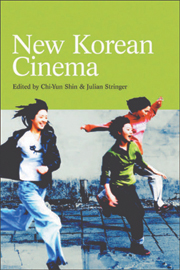Book contents
- Frontmatter
- Contents
- Notes on the Contributors
- List of Illustrations
- Introduction
- Part I Forging a New Cinema
- Part II Generic Transformations
- 6 Putting Korean Cinema in its Place: Genre Classifications and the Contexts of Reception
- 7 Horror as Critique in Tell Me Something and Sympathy for Mr.Vengeance
- 8 Two of a Kind: Gender and Friendship in Friend and Take Care of My Cat
- 9 ‘Just Because’: Comedy, Melodrama and Youth Violence in Attack the Gas Station
- 10 All at Sea? National History and Historiology in Soul's Protest and Phantom, the Submarine
- Part III Social Change and Civil Society
- Glossary of Key Terms
- Bibliography of Works on Korean Cinema
- Websites
- Index
9 - ‘Just Because’: Comedy, Melodrama and Youth Violence in Attack the Gas Station
from Part II - Generic Transformations
Published online by Cambridge University Press: 05 August 2013
- Frontmatter
- Contents
- Notes on the Contributors
- List of Illustrations
- Introduction
- Part I Forging a New Cinema
- Part II Generic Transformations
- 6 Putting Korean Cinema in its Place: Genre Classifications and the Contexts of Reception
- 7 Horror as Critique in Tell Me Something and Sympathy for Mr.Vengeance
- 8 Two of a Kind: Gender and Friendship in Friend and Take Care of My Cat
- 9 ‘Just Because’: Comedy, Melodrama and Youth Violence in Attack the Gas Station
- 10 All at Sea? National History and Historiology in Soul's Protest and Phantom, the Submarine
- Part III Social Change and Civil Society
- Glossary of Key Terms
- Bibliography of Works on Korean Cinema
- Websites
- Index
Summary
Attack the Gas Station (Juyuso sŭpgyŏksagŏn, 1999, dir. Kim Sang-jin) is a violent comedy: despite the considerable violence that runs the entire course of the film, the film has been widely appreciated as hysterically funny. In the words of one critic, ‘This is the first truly comedy-like South Korean comedy action film that I've seen in a long time’. The plot is this: four young men attack a petrol station, holding its ‘president’ (sajang) and workers hostage. Viewers laugh hard, for example, at radical role reversals: at the petrol station ‘president’ who offers to relinquish his presidency the moment he is instructed to ‘bow down, head down!’ because he is the ‘president’; or at the dumbfounded response of petrol-station customers who are told that ‘today is a cash and full-tank-only day’. This humour aside, there are moments that make us wince – when the violence, some of it misogynistic, is simply too ruthless to laugh away: for example, when the attackers lock a defiant woman in the boot of her car and proceed to hack at the boot (the film ends having left her and another customer locked away); or when, time after time, one of the attackers smashes the painstakingly repaired telephones that he had commanded the ‘president’ to fix. A box-office success, Attack the Gas Station ranked second among domestic films in 1999 (garnering slightly less than one-half of the viewers of history-making Shiri [Swiri] – 962,000 in Seoul by its eleventh week) and third overall (only slightly overshadowed by the American film The Mummy) (see www://koreanfilm.org).
- Type
- Chapter
- Information
- New Korean Cinema , pp. 132 - 143Publisher: Edinburgh University PressPrint publication year: 2005



